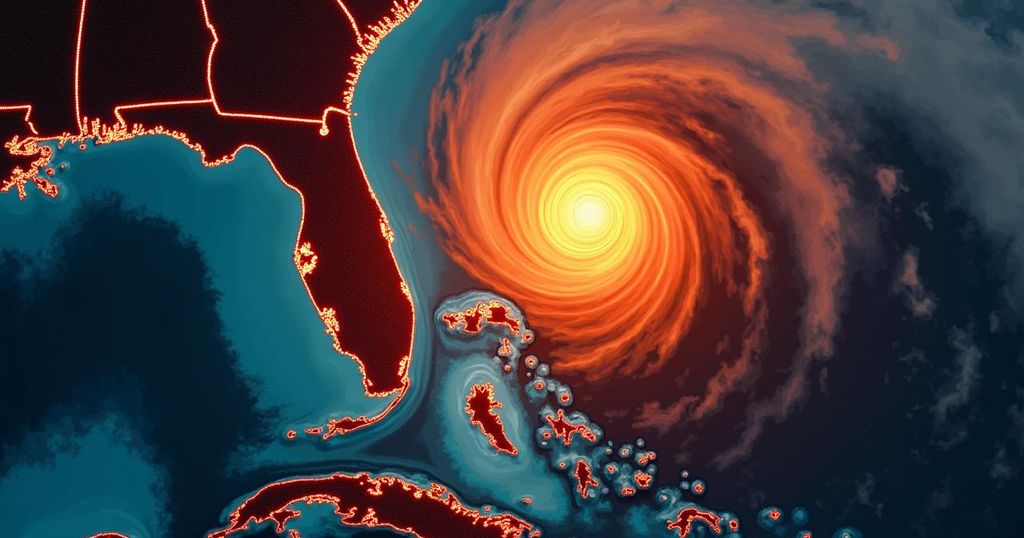Hurricane Kirk’s Potential Impact on Florida and the Atlantic
Hurricane Kirk is a Category 3 storm in the central Atlantic, expected to strengthen to a Category 4 with winds up to 140 mph. While primarily over open waters, it may influence the east coast of the U.S. by Sunday. Florida could face heavy rains from a different system approaching the Gulf. Preparations are underway as both Hurricane Kirk and Tropical Storm Leslie develop further.
Hurricane Kirk is currently a significant hurricane located in the central Atlantic, characterized as a Category 3 storm with sustained winds of 120 mph. It is projected to intensify into a Category 4 storm with maximum sustained winds of 140 mph within the next 24 hours. Despite remaining primarily over the open Atlantic waters, the impact of Hurricane Kirk could be felt on the east coast of the United States as early as Sunday. In addition to Kirk, the Atlantic basin is experiencing activity from other systems, including Tropical Storm Leslie, which is expected to develop into a hurricane, and a separate system approaching the Gulf of Mexico. The latter is foreseen as a potential source of heavy rainfall and flooding in Florida, regardless of its classification as a tropical storm or hurricane. At present, Hurricane Kirk is moving northwest at a speed of 10 mph and is located approximately 1,185 miles east of the Northern Leeward Islands and 1,645 miles southwest of the Azores. The current forecast indicates that Kirk will turn northward at an increased speed by the weekend, and its size will expand, generating ocean swells across the central and western Atlantic. The National Hurricane Center has cautioned that these swells may lead to elevated surf conditions and rip currents in various regions, including the Leeward Islands, Bermuda, and the U.S. East Coast by Sunday. As Hurricane Kirk’s conditions unfold, it has momentarily halted its intensification after experiencing a rapid increase in wind speeds earlier this week. Hurricane-force winds are reported to extend outward up to 35 miles from the center while tropical-storm-force winds extend out to 185 miles. As preparations for any potential impacts are underway, the National Hurricane Center continues to monitor the situation closely, utilizing various forecasting models to inform predictions. Meanwhile, Tropical Storm Leslie, currently situated 515 miles southwest of the Cabo Verde Islands and moving westward, is projected to strengthen and could become a hurricane by early Saturday. It is identified as a potential threat to trans-Atlantic shipping but is not anticipated to impact land. In summary, while Hurricane Kirk poses a significant risk, particularly to marine interests in the Atlantic, the state of Florida may experience substantial rainfall due to another system moving towards the Gulf region. Residents are urged to remain vigilant and informed about evolving weather conditions.
Hurricanes are powerful tropical storms that can have catastrophic effects on coastal and inland areas. The classification of hurricanes is determined using the Saffir-Simpson Hurricane Wind Scale, which categorizes storms based on their sustained wind speeds. The impacts of hurricanes can extend beyond immediate areas of landfall, with effects including dangerous surf conditions, rip currents, and rainfall that can lead to flooding. Tracking and forecasting these storms are crucial for preparedness, especially for regions like Florida that are frequently in the path of tropical systems. The National Hurricane Center and meteorological organizations provide updates that inform both the public and shipping industries of potential dangers posed by these storms, including emerging systems like Hurricane Kirk and Tropical Storm Leslie.
In conclusion, Hurricane Kirk is projected to strengthen into a Category 4 storm, primarily affecting the Atlantic with potential waves and surf impacts reaching the U.S. East Coast. Although Florida may not be directly impacted by Hurricane Kirk, it is bracing for heavy rainfall from other impending storms as part of the Gulf system. Awareness and preparedness remain essential as weather patterns evolve.
Original Source: www.news-press.com




Post Comment